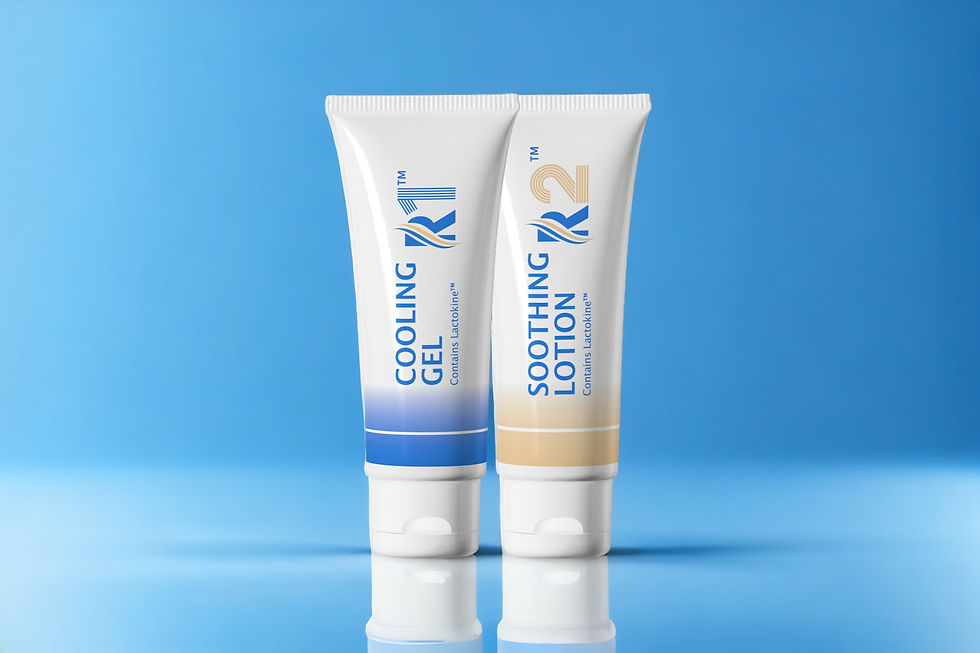Radiotherapy Skincare
- CancerPal

- May 10
- 4 min read
Updated: Jun 22

Jo McNamara and Naman Julka-Anderson are therapeutic radiographers who have joined forces to create RadChat: a CPD-accredited podcast that makes advanced therapeutic radiography knowledge engaging and accessible. In Episode 7 of RadChat, Jo and Naman discuss Radiotherapy Skincare and in this article, we share some of their advice. You can listen to the full podcast here.
Disclaimer: Jo and Namen don't offer any specific advice as you do need to speak to your radiotherapy team for this, but anything they discuss is based on evidence based information from the Society of Radiographers.
What makes a skin reaction worse?
Namen tells us that the risk factors that can make a skin reaction worse will vary between people. These factors can be split into intrinsic factors, which are not in the patient's control and extrinsic factors, which are sometimes in the patient's control.
Intrinsic factors include the type of treatment you are offered e.g. are you having chemotherapy at the same time or is the radiation dose going to be a lot higher than for some other treatment areas.
Extrinsic factors include whether you smoke, your nutritional status, or any co-morbidities such as diabetes which can reduce blood flow and increase skin reactions.
Namen goes onto explain that some cancer sites won't get a skin reaction at all, because of the advancements in technology, such as skin sparing or where they ensure that the skin gets a lot less dose and where they want to treat gets most of the dose.
However some head and neck patients, breast cancer patients and sometimes skin cancer patients can have quite severe skin reactions because the skin is a lot thinner in these places and they tend to get a much higher overall dose compared to other treatments.
Namen also states that some gynaecological or anal cancers can get a skin reaction in the natal cleft (the groove between the buttocks) which can be quite severe.
When will I get a skin reaction?
Namen tells us that you could notice a redness or a darkness of the skin within a couple of hours of radiotherapy, but usually it is all about accumulation, so patients may notice skin becoming gradually pinker or darker within the area right up to the end of treatment. If not, Namen tells us that from evidence, we know that it's about 10-14 days after radiotherapy that skin reactions can peak, but they can go on longer than this and this is where the risk factors come in.
Patients who have had chemotherapy for example, we know through evidence that they can have a skin reaction for longer or the skin reaction can take longer to heal.
Also, the drier your skin, for example if someone has diabetes or eczema, sometimes the skin is really dry and that can cause the radiotherapy reaction to be amplified because the skin is not able to heal as quickly.
Namen states that skin reactions aren't always avoidable but they can be managed by getting the skin ready prior to radiotherapy by using a moisturiser.
Is a skin reaction reversible?
Jo explains that when we are exposed to radiation, our cells have an amazing ability to repair any damage, so not all radiation effects are irreversible, meaning that many radiation side effects are short term, such as skin irritations. Skin irritation is a result of the short term damage that radiotherapy has caused in our cells, but in most cases, they are able to repair themselves.
Can I use a cold compress on radiotherapy affected skin?
With a radiotherapy related skin reaction, the skin can become slightly warm and irritated and it can be tempting to place a cold compress or an ice pack on the skin to help cool it. However, Namen advises that because a cold compress or ice pack tends to be used over a long period of time, it can reduce blood flow to the area, which from a radiotherapy healing point of view isn't a good thing, as blood flow in the area can promote healing.
However, Namen does state that keeping a moisturising cream in the fridge can be a good way to offer instant cooling relief to a skin reaction site.
Namen's and Jo's Skincare Top Tips:
It's really important to consider getting your skin ready for radiotherapy, by using a moisturiser. Speak to a dermatologist or your treatment team for specific advice on what products you can use.
Give up or cut down on smoking, because smoking can really amplify a skin reaction.
Any area that has been treated by radiotherapy is always going to be more susceptible to sun damage because it has been treated by radiation. It's important to keep the area being treated, covered as best you can during treatment. While having radiotherapy and for a couple of weeks after radiotherapy, avoid at all costs putting any sun cream in the area because the metallic elements in the sun cream can really amplify and make the skin reaction worse. Once the treatment is over and you have recovered, so maybe 2-3 weeks after, you can start applying sun cream to the treated area, but it should always be at least a factor 50 and above and always ensure that it is certified to protect against UVA and UVB radiation.
Remember there are differences in skin reactions between patients so lighter skin tones can look redder but on darker skin tones it will be more pigmented or darker.
If your skin is starting to feel tingly or it's keeping you awake at night please let your radiotherapy team know so that they support you with personalised care.
CancerPal stocks a range of skin care products to help you look after your skin during radiotherapy treatment in the skincare section of our CancerPal MarketPlace.



